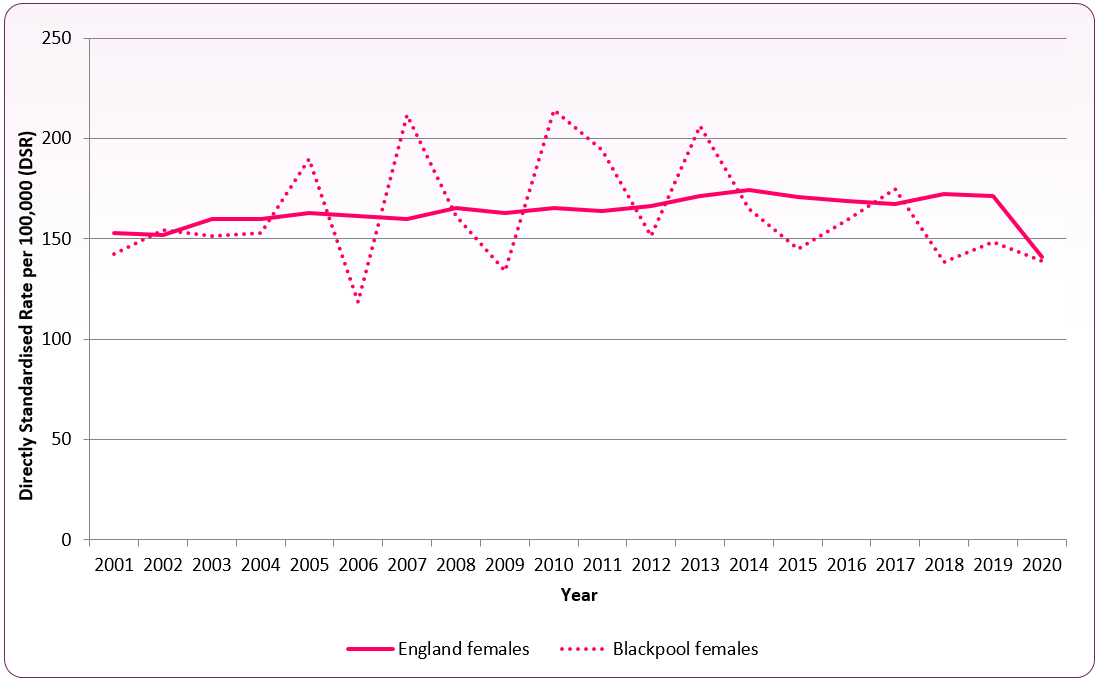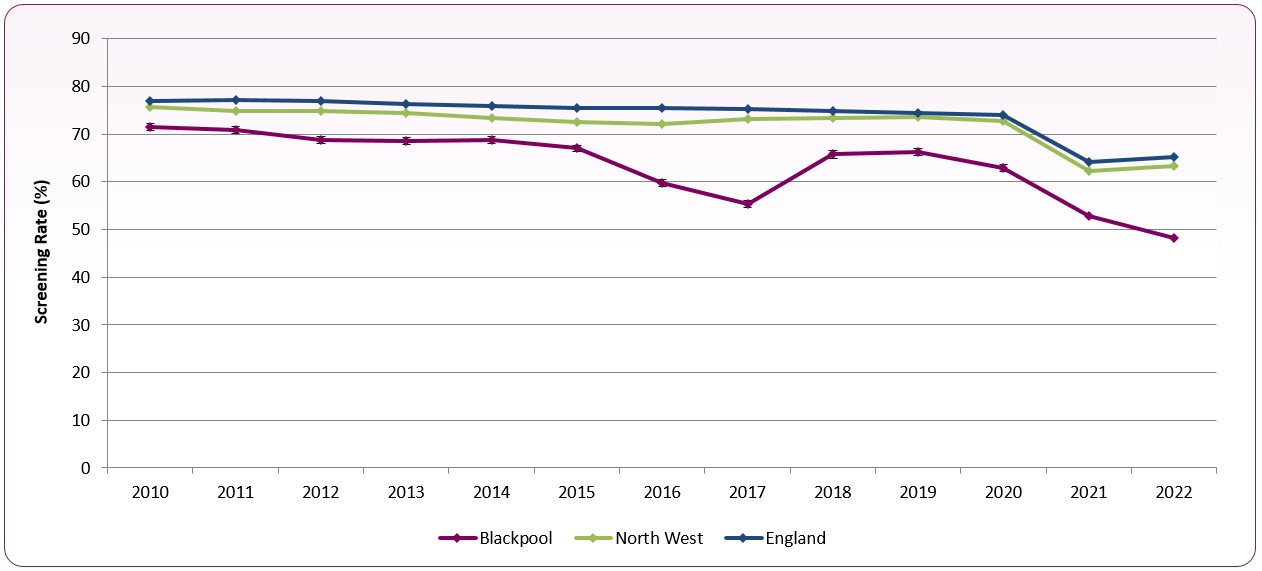Breast Cancer
Last Modified 30/11/2023 13:46:46
Share this page
Introduction
Cancer Research UK provides a brief guide to breast cancer that includes information about symptoms, early detection, screening for breast cancer and possible risk factors.
Facts and figures
Incidence of breast cancer
Incidence is defined as the number of new cases identified in a given period of time.
In Blackpool each year there are approximately 121 new cases of breast cancer identified. Figure 1 shows the trend in the cancer incidence rate in Blackpool and England. The incidence rate (in this case per 100,000 population) is calculated to allow comparison between geographies of different population sizes and with different age make ups.
Breast cancer incidence has dropped both nationally and locally. This is likely to be due to the reduced screening over the past three years since the COVID-19 pandemic. Comparatively, breast cancer incidence in Blackpool is similar to the national incidence rate.
Figure 1 - incidence of breast cancer - 2001-2020 annual trend
 Source: National Cancer Registration and Analysis Service (NCRAS)
Source: National Cancer Registration and Analysis Service (NCRAS)
Mortality from breast cancer
Each year in Blackpool there are approximately 31 deaths due to breast cancer. The directly standardised mortality rate (in this case per 100,000 population) is calculated to allow comparison between geographies of different population sizes and with different age make ups. Between 2018 and 2020 the rate of breast cancer deaths in Blackpool was 34.3 per 100,000, slightly higher than the England rate of 32.5 per 100,000 (directly standardised rate). Lifestyle factors and other wider determinants of health are not significant risks in developing breast cancer, and most geographical areas across England have similar rates of breast cancer mortality.
Breast cancer survival rates
Cancer survival rates are estimates of the percentage of people still alive after a diagnosis, over a specific time period. It usually only refers to primary cancers and does not include secondary cancers or recurrences.
The one-year breast cancer survival rate for both Blackpool and England has steadily increased since 2005. In 2020 the survival rate for breast cancer in Blackpool was 96.3%, compared to 88.6% in 2005. Across England the one-year survival rate in 2020 was 97.3% (compared to 94.7% in 2005).
Breast cancer screening
The NHS administers a national cancer screening programme aimed at detecting early symptoms of breast cancer. Breast cancer screening is included as a local authority level indicator within the Public Health Outcome Framework. The definition of this breast cancer screening coverage measure is, the proportion of women aged 53-70 resident in the area with a screening test result recorded in the previous three years.
Blackpool achieved a screening coverage rate of 48.2% in 2022, falling from 52.8.0% in 2021. This reflects the impact of COVID-19 on breast cancer screening programme delivery during the COVID pandemic (including the suspension of the programme in March 2020), and the reduced number of women presenting for breast screening over the COVID period.1 This reduced uptake may have an impact on both breast cancer incidence and mortality over the coming years.2
Figure 3 illustrates that eligible women living in Blackpool are significantly less likely to be screened for breast cancer than in the North West region or England as a whole.
Figure 3 - breast cancer screening coverage
 Source: OHID, Public Health Profiles
Source: OHID, Public Health Profiles
National and local strategies (current best practices)
-
- National Institute for Health and Care Exellence (NICE) provide guidance, advice, NICE Pathways and quality standards on breast cancer
Risk factors
Cancer Research UK has compiled a summary of risk factors and causes of breast cancer.
NHS Digital (2022) NHS Breast Cancer Screening Programme, England, 2020-21: COVID-19 impact during 2020-21.
See, for example, Duffy, S.W., Seedat, F., Kearins, O. et al (2022) The projected impact of the COVID-19 lockdown period on breast cancer deaths in England due to the cessation of population screening: a national estimation. British Journal of Cancer, 126, 1355-1361. https://doi.org/10.1038/s41416-022-01714-9.